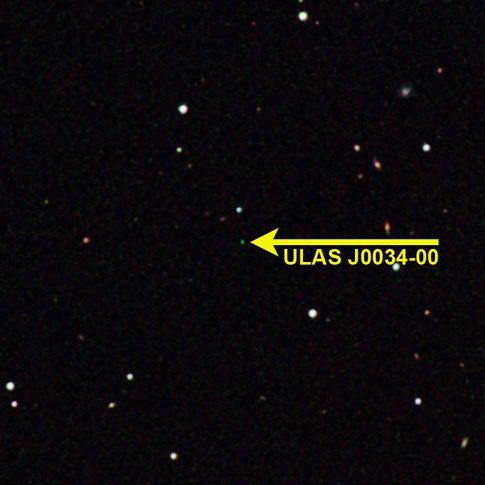The finding was announced at the 210th American Astronomical Society meeting in Honolulu, Hawaii, by an international team of astronomers that used the United Kingdom Infrared Telescope (UKIRT) and made followup observations with Gemini Observatory’s Near Infrared Spectrograph (GNIRS) on Gemini South. Their discovery suggests that even lower-mass objects could be found. If so, they would continue to test the boundary between high-mass planets and the smallest brown dwarfs.
J0034 was discovered in the very early stages of the UKIRT Infrared Deep Sky Survey (UKIDSS), the world’s deepest-ever near-infrared sky survey, using an instrument called the Wide Field Camera (WFCAM). The brown dwarf is particularly remarkable since it has a lower temperature than any such object previously discovered. According to team leader Steve Warren of Imperial College London, “Only planets are cooler, and they are by definition bound to a parent star.”
The discovery was initiated by post-doctoral researcher Daniel Mortlock, who first noticed the unusual object in the UKIRT survey images. “Identifying an object like J0034-00 is a more challenging version of finding a needle in a haystack,” Mortlock said. “In this case it was like looking for a piece of slightly reddish straw rather than a nice shiny needle.”
Follow-up spectroscopic observations, critical for determining the brown dwarf’s temperature and likely mass, were obtained with the Gemini South Telescope in Chile. “The infrared spectrum of J0034 confirmed that we had found a very cool brown dwarf,” said Dr. Sandy Leggett of Gemini Observatory. “However, it wasn’t until we made a detailed study of the water steam and methane features, and compared them to other brown dwarf spectra, that we realized we had the coolest dwarf ever seen.”
The final piece of the puzzle — precisely determining J0034’s distance accurately by using its apparent motion due to parallax as the Earth moves in its orbit — will have to wait for a year or so. However, astronomers expect to find that it is about 50 light-years away. This is closer to Earth than many of the stars that can be seen with the naked eye, and leaves open the exciting prospect of finding additional, even cooler objects lurking in our solar neighborhood.
According to Mortlock, finding the correct distance is important. “The model brown dwarf spectra, from which we make some of our inferences about the temperature and other properties of J0034, is probably ‘incomplete’, in the sense that not all the effects of the molecules in the brown dwarf’s atmosphere are included fully,” he said. “Thus, getting a completely independent distance measure (and hence an independent luminosity) is an important final check to make sure that J0034 has the size and temperature we think it does.”
J0034 was discovered in the UKIDSS survey’s First Data Release (DR1), which covers only five per cent of the final survey area. Combined with the discovery of a number of hotter brown dwarfs in the same data, this implies that UKIDSS will likely discover even more exotic objects as it continues its census of the coolest stars in the solar neighborhood.
“Fully bridging the gap between stars and planets is one of the key aims of the UKIDSS survey, and it’s wonderful to see these aims starting to be fulfilled at such an early stage of the survey program,” said Dr. Andy Adamson, Associate Director of UKIRT.
UKIDSS is expected to be completed by 2012, by which time it will have covered almost a quarter of the sky and hopefully further explored the cool, low-mass objects that are defined somewhere between stars and planets.










